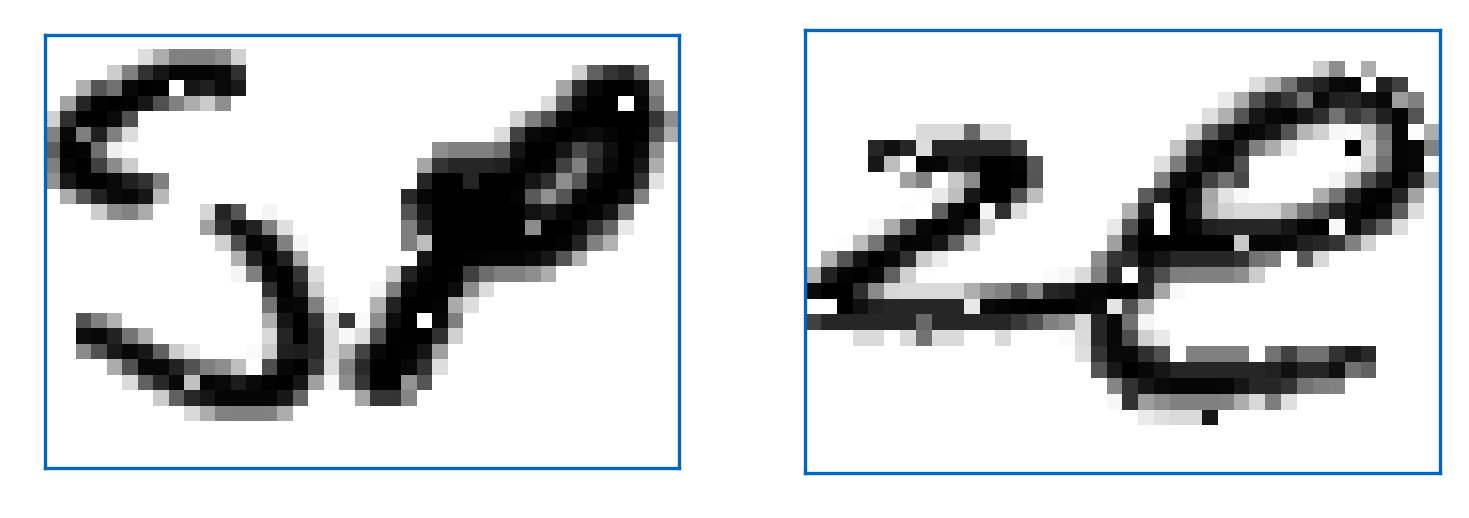The goal of this project is to predict handwritten letters on images with noise similar to traditional CAPTCHA images. The training data is from the EMNIST, a balanced dataset of handwritten lowercase and uppercase letters from the Latin alphabet. The total size of the training data is 124,800 images, with each letter represented 4,800 times. Images are represented as arrays with grayscale pixel values ranging from 0 (white) to 255 (black).
 Figure 2: Random examples of handwritten letters.
Figure 2: Random examples of handwritten letters.
A CNN is a special design of neural network for processing data that has a grid-like structure, like images that can be represented as a grid of pixels. CNN takes its name from the mathematical linear operation between matrices called convolution (Albawi et al., 2017). A survey by Baldominos et al. (2019) characterizes CNNs as the state-of-the-art approach of solving handwritten character recognition problems.
The architecture of the CNN model consists of seven layers: four convolutional and three fully-connected (dense) layers. The first layer uses a filter of 64 and a 5x5 kernel with strides of 2x2, the second layers a filter of 32 and a 2x2 kernel with strides of 1x1. The sub-sampling method I employ is maxpooling, for regularization I include dropout layers. The third and fourth layers have the same architecture asthe first and second layers. The two dense layers that follow to convolutional layers consist of 128 units, thefinal dense layer embodies 26 units (the number of classes) and has a Softmax activation function.
The trained CNN model achieves a test accuracy of 95.06%.
 Figure 2: Random examples of misclassified letters. (prediction in blue)
Figure 2: Random examples of misclassified letters. (prediction in blue)
Step 1: Removing the noise
To remove the pepper noise from the image, I apply a Gaussian blur and create a threshold that masks the original image. This approachis relatively successful in most cases.
| Original image | Denoised image |
|---|---|
 |
 |
Step 2: Separating contours
The biggest challenge is to separate the four individual letters in the image. Some images have sufficient white space between letters so that it is easy to find the four contours. Others have connected or even overlapping letters that result in fewer identifiable contours in the denoised image.
Step 3: Cleaning images
The images that result from the contour identifications are then cleaned to ensure that there are four images withthe required dimensions. This step involves the splitting, padding, and normalization of images. The outcome is a set of four images that - in most cases - look similar to the images that the CNN was trained on.
| Seperated images | Cleaned images |
|---|---|
 |
 |
Step 4: Predicting images I then let the CNN predict the four images. I consider the five most probable predictions by the model. The correct label is among the top five predictions for 68.0% of the "corrupted" images.
Gregory Cohen, Saeed Afshar, Jonathan Tapson, and Andre Van Schaik. Emnist: Extending mnist tohandwritten letters. In 2017 International Joint Conference on Neural Networks (IJCNN). IEEE, 2017.
Saad Albawi, Tareq Abed Mohammed, and Saad Al-Zawi. Understanding of a convolutional neural net-work. In 2017 International Conference on Engineering and Technology (ICET), 2017.
Alejandro Baldominos, Yago Saez, and Pedro Isasi. A survey of handwritten character recognition withmnist and emnist. Applied Sciences, 9(15), 2019.5
